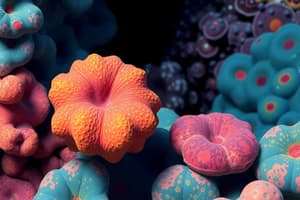Podcast
Questions and Answers
What distinguishes the body organization of sponges from that of protozoans?
What distinguishes the body organization of sponges from that of protozoans?
Sponges have a cellular level organization with specialized cells, while protozoans operate as a single cell carrying out all life activities.
What is the primary function of the canal system in sponges?
What is the primary function of the canal system in sponges?
The canal system allows for the entrance of water and food, as well as the exit of waste products.
Name the four classes of Phylum Porifera and briefly describe one characteristic of each.
Name the four classes of Phylum Porifera and briefly describe one characteristic of each.
- Calcarea - calcareous sponges with calcium carbonate spicules; 2. Hyalospongia - glass sponges with silicious, usually 6-rayed spicules; 3. Demospongeae - sponges with a silicious internal skeleton and sponging fibers; 4. Sclerosponeae - sponges with a hard composite skeleton.
What material are the spicules of Class Calcarea made from?
What material are the spicules of Class Calcarea made from?
What type of skeletal structure is found in Class Demospongeae?
What type of skeletal structure is found in Class Demospongeae?
How do sponges differ in terms of tissue organization compared to more complex animals?
How do sponges differ in terms of tissue organization compared to more complex animals?
Flashcards are hidden until you start studying
Study Notes
Overview of Phylum Porifera
- Consists of multicellular animals known as sponges, regarded as the simplest form of multicellular life.
- Sponges have a cellular level organization, differing from protozoans which function as single cells.
- Their bodies feature perforated cavities allowing the water and food intake while facilitating waste removal.
Body Structure and Characteristics
- Body perforated with pores, leading to a canal system for nutrient and waste management.
- Skeleton composed of spicules or spongin fibers, which provide structural support.
- Lacks organs of a digestive tract and well-defined tissues, making them unique among multicellular organisms.
Classes of Phylum Porifera
-
Class Calcarea
- Comprises calcareous sponges.
- Spicules composed of calcium carbonate, varying in structure between one, three, or four rays.
-
Class Hyalospongia
- Includes glass sponges characterized by siliceous spicules.
- Typically has six-rayed spicules, providing distinct identification.
-
Class Demospongeae
- Features a diverse range with an internal skeleton that may be siliceous or composed of spongin fibers.
-
Class Sclerosponeae
- Contains species with a hard internal skeleton.
- Skeleton composed of a combination of aragonite and other materials.
Studying That Suits You
Use AI to generate personalized quizzes and flashcards to suit your learning preferences.




